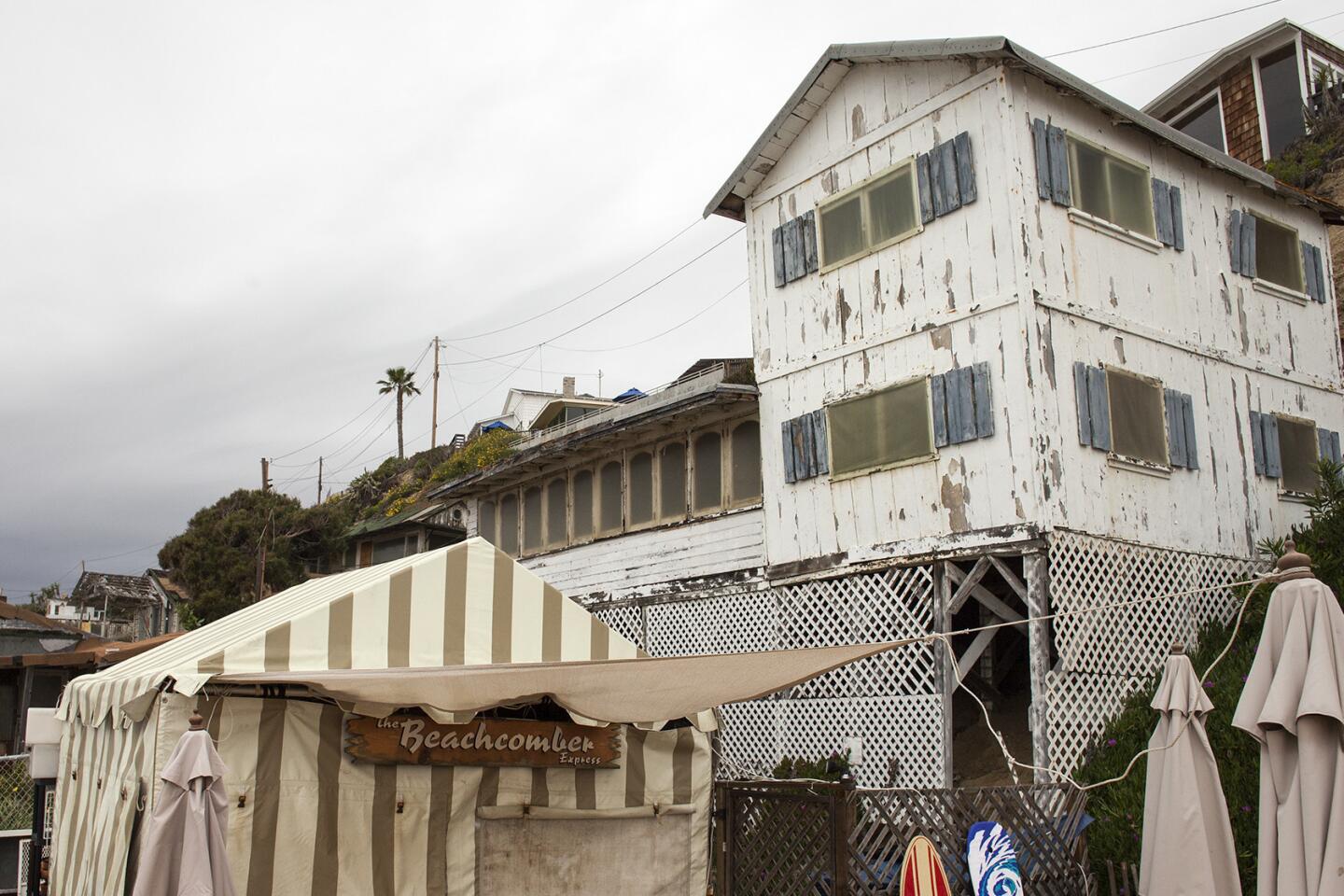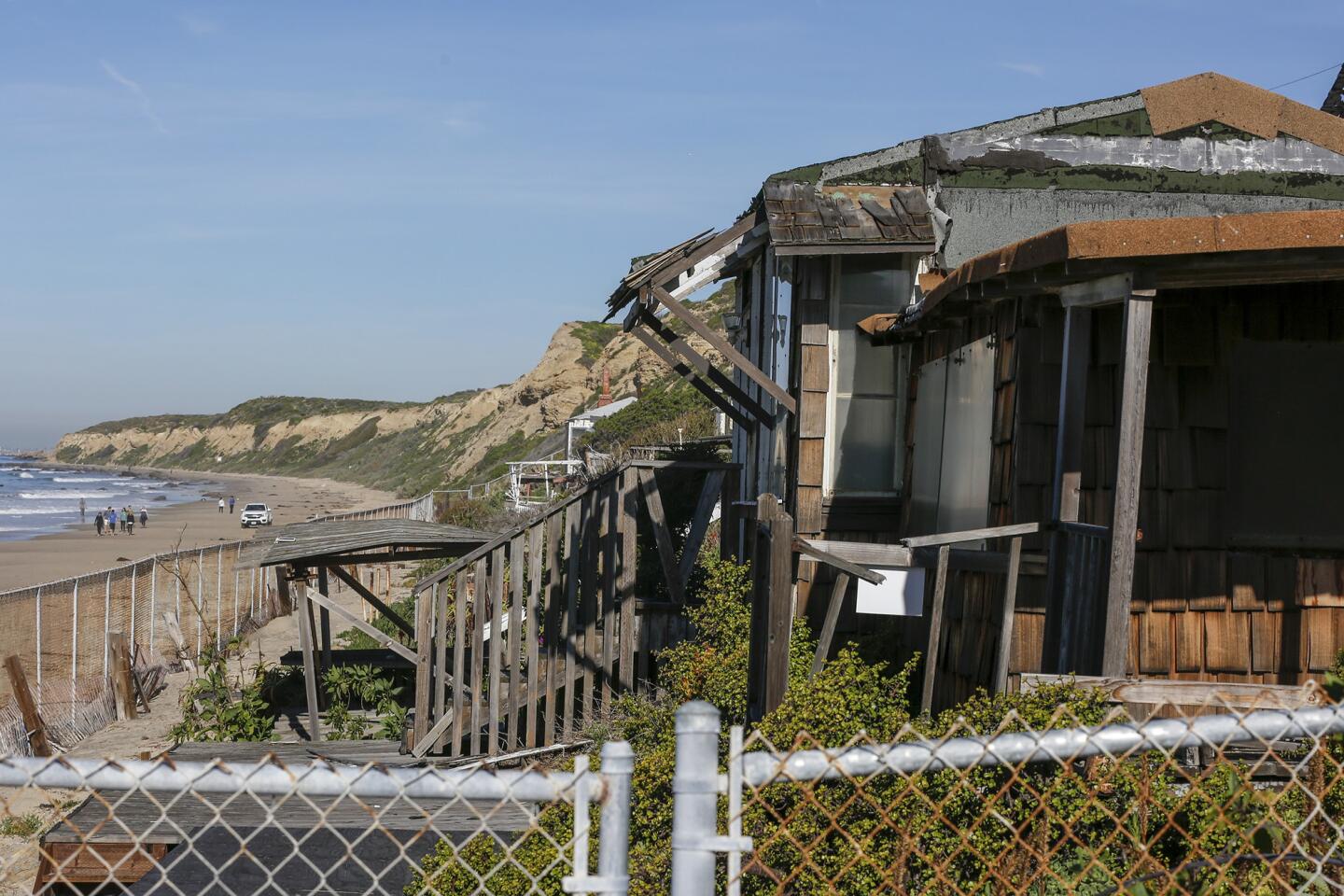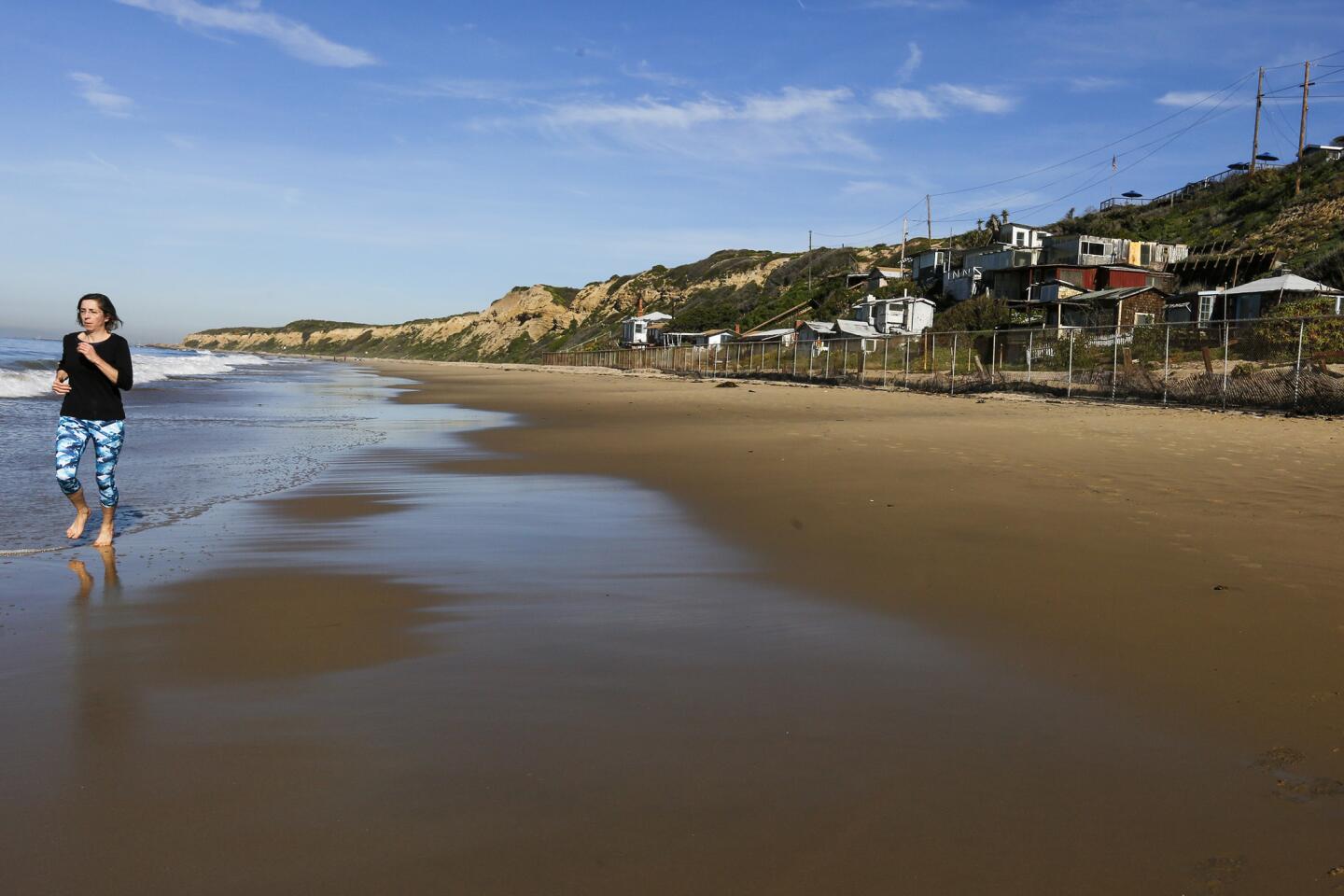Rebuilding Crystal Cove enters its final stage
- Share via
The 17 weathered cottages sit behind a fence at the base of a bluff that runs parallel to the ocean at the northern tip of Crystal Cove State Park.
Remnants of a wooden boardwalk lean up against the base of the fence, while iceplant covers nearly all of a dirt path.
It’s hard at this moment to envision the beach parties that would draw people from the movie industry to these now-historic rentals for days of playing volleyball and sipping sodas at the beachfront soda fountain. Laura Davick, who spent much time at the cove, remembers being among those who kept horses at a nearby stable for taking rides up and down the coast.
The seaside paradise attracted Hollywood filmmakers, artists and families — even before the 46 cabins were constructed, primarily in the 1920s and ‘30s. The 1918 movie “Treasure Island” was filmed at Crystal Cove.
The completion of Pacific Coast Highway in 1926 brought a new wave of explorers. They started taking over the movie-making remnants or building their own housing out of stray materials, including lumber from the 287-foot schooner named Ester Buhne that wrecked at Balboa Point in 1927, according to KCET.
Families claimed the cottages year after year, even though they had no official rights to the land. For a time cottage dwellers had year-to-year leases on their structures, though that changed to 10-year agreements in 1940, Davick said.
On a recent visit to Cottage No. 12, built in 1929, Davick, founder and vice president of the nonprofit Crystal Cove Alliance, removed a rubber porch mat that had nails sticking out of it. Ends of inactive electrical wires could be seen peeking through a wall near the front door.
Inside, the plywood floor gave way a little with each step, causing one to question its stability. A row of windows facing the ocean had become so clouded that it was impossible to see the water.
A narrow staircase leads to the upstairs bedrooms, which sit empty. A light fixture hangs from the ceiling in one room. The original sinks in the bathrooms came from the Hotel del Coronado in Coronado, Davick said.
Not far away are 29 cottages that have been restored and are being rented, but this one, like 16 others, have been vacant since 2001, when a developer proposed a plan for converting the site’s 46 cottages into what the Los Angeles Times called “high-priced hotel cabins” at the seaside enclave between Newport Beach and Laguna Beach.
The state had purchased the land from the Irvine Co. in 1979, intending to preserve the area as a state park.
The fight begins
Davick recalled the date: Jan. 18, 2001.
That night, at Lincoln Elementary School in Corona del Mar, the California Department of Parks and Recreation and developer Michael Freed, from San Francisco-based Passport Resorts, were ready to present their plan for converting 46 cottages into 73 units, adding three swimming pools and building a 150-seat restaurant at Crystal Cove State Park.
But a group of advocates, including Davick, whose family leased one of the cottages for 41 years, pushed back.
As Davick told the story, Freed never got a chance to present the plan to the hundreds gathered at the school.
“People would not let them talk,” said Davick, who two years earlier founded the Alliance to Rescue Crystal Cove, which is now the Crystal Cove Alliance. For more than a year before the meeting, Davick had developed an alternative plan that would keep the cottages, listed on the National Register of Historic Places, intact and make them available to the general public for overnight use.
That night, the history for Crystal Cove changed. As I drove away, I thought, ‘This resort is not happening.’
— Laura Davick, vice president of the nonprofit Crystal Cove Alliance
“That night, the history for Crystal Cove changed,” Davick said recently as she sat at a picnic table, steps from the sand along the 3.2-mile stretch of coastline. A father threw a Frisbee with his son, while others walked along the sand admiring the gently crashing waves.
“As I drove away, I thought, ‘This resort is not happening.’”
The California Coastal Conservancy eventually voted to spend up to $2 million of taxpayer money to buy back a 60-year lease the state signed with Freed in 1997, according to The Times.
Thus began a quest to restore the cottages to their former glory. In the last 16 years, the alliance, in partnership with the state, has brought back to life, in two phases, 29 of the 46 cottages.
Now comes the final stage: restoring the remaining 17 time-worn structures and making them habitable again.
The latest restoration will involve a partial dismantling, with every effort made to reuse the original materials, according to a California Coastal Commission staff report.
“Each cottage has its own personality, its own unique stories,” Davick said.
Earlier this month the alliance and state received a coastal development permit from the commission for the work, which involves adding utility lines, building a 650-foot-long boardwalk on caissons, and constructing a 20-foot-high, 120-foot-long wall to protect two of the cottages from potential erosion.
Alliance officials said the project could cost $30 million, adding that firm estimates will be determined in the coming months. About the half the cost will cover infrastructure, such as utilities, while the remainder will cover restoration of the cottages, said Alix Hobbs, the alliance’s president and chief executive.
Educational component
With the approval, the alliance received $5 million that had been earmarked for Crystal Cove.
In September 2007, the commission approved a town home project in Newport Beach upon the condition that the developer contribute the money for lower-cost, visitor-serving uses, such as affordable lodging on the coast, commission spokeswoman Noaki Schwartz wrote in an email.
Of the $5 million, $1 million will go into an endowment for a coastal engineering educational program. Junior high and high school students, primarily from low-income families, will travel to the coast to learn and conduct experiments on topics such as sea-level rise, climate change and erosion.
The $1 million will help pay for student transportation and any needed equipment and supplies, said Hobbs.
Alliance staff, and faculty from UC Irvine’s Henry Samueli School of Engineering will design the curriculum, lessons and experiments.
The excursions will eventually go beyond single-day field trips. Students will spend two nights in one of the refurbished cottages and step outside into their classroom — on the beach.
“Some of these students have never been to the coast,” Hobbs said.
The goal is to engage students in hands-on projects and encourage students to pursue careers in scientific disciplines, Hobbs added.
“We want to introduce students to what it means to be an environmental scientist,” Hobbs said.
Brett Sanders, chairman of UCI’s Department of Civil and Environmental Engineering, called Crystal Cove a prototype for studying how man-made structures interact with the natural environment.
“How do we strike a balance of protecting natural systems and the California quality of life?” Sanders said rhetorically.
The alliance and UCI currently partner on offering students opportunities to gather research from a boat on the ocean, known as the Marine Protected Area Citizen Science Cruise.
Students conduct fish counts with underwater cameras, do plankton tows behind the boat and are also on the lookout for marine mammals, Hobbs said.
The educational component was an important part of the overall vision of Crystal Cove, Davick said.
“When people think about Crystal Cove, they think about [cottage] rentals and the Beachcomber [a restaurant on the property],” Davick said. “Last year, [students in the educational programs] grew by 57%.
“Rentals are the tip of the iceberg.”
The alliance expects to raise the estimated remaining $22 million. It has $3 million from an anonymous donation.
Infrastructure work, which could start next year, will occur before restoration of the cottages begins. Once started, restoration of the the remaining 17 cottages is expected to take five years.
For those itching to get a glimpse of the restored cottages and surrounding environs, Davick leads free, two-hour tours from noon to 2 p.m. on the third Sunday of every month, except December.
For more information about the alliance, visit crystalcovealliance.org.
Twitter: @AldertonBryce





